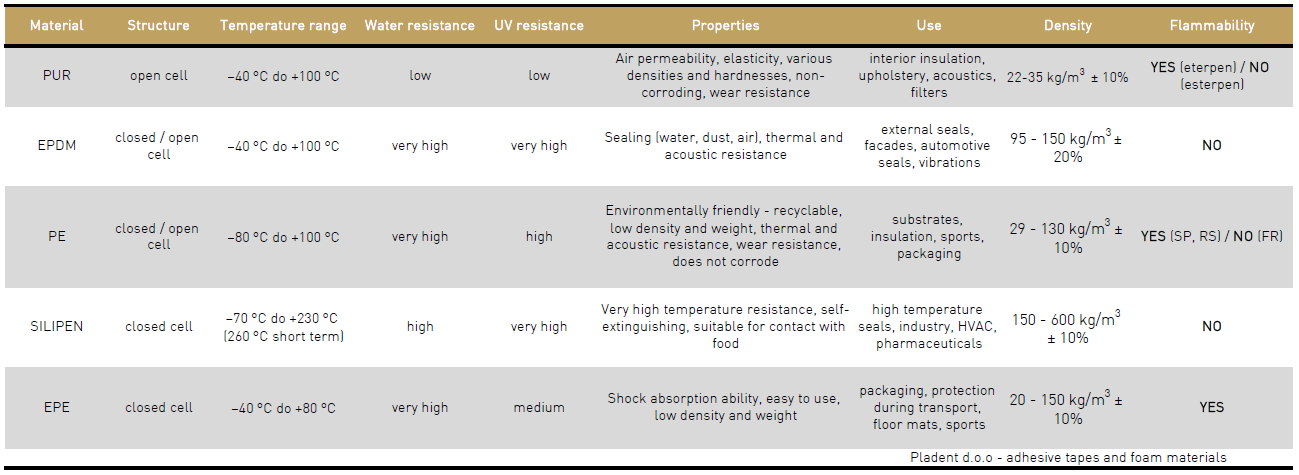Foam materials: PUR, EPDM, PE, SILIPEN and EPE – properties, application and comparison
Foam materials are practically indispensable in industry and everyday life. Their diversity allows them to be used in a wide variety of industries – from construction, automotive, electronics, to furniture, sports and even everyday household products.
But despite the fact that we encounter them regularly, we often do not think about how different their properties are and why choosing the right foam is crucial for the effectiveness and durability of the solution.

What are foams and why are they important?
Foams are materials with open or closed cells that provide exceptional lightness, flexibility and insulation. They are used for thermal and acoustic insulation, sealing, protection of sensitive products during transport, cushioning and more. Each foam has its own specifics that affect its suitability for a particular application.
Below we present some of the most widely used foams: polyurethane foam (PUR), EPDM foam rubber, polyethylene foam (PE), SILIPEN silicone foam and expanded polyethylene foam (EPE), which is most often found in packaging.
Polyurethane foam (PUR): a versatile solution for insulation and sealing
PUR foam is soft and flexible with an open cell structure, which gives it excellent sound insulation and pressure resistance. Due to these properties, it is often used in construction for thermal and sound insulation of walls, ceilings and floors, as a shock absorber. In addition, it is also suitable for the production of seals and sealing strips that prevent air and moisture leakage, thereby contributing to greater energy efficiency of buildings.
Its disadvantage is lower resistance to UV radiation and long-term moisture, so it is more suitable for indoor use.
EPDM foam – a durable choice for outdoor conditions
EPDM foam is a foam-based rubber that is characterized by its exceptional resistance to weathering, UV rays, ozone, temperature fluctuations and aging. It is available in various densities, as closed-cell or open-cell.
It is often used as seals on windows, doors, facades, in the automotive industry or wherever high-quality sealing and vibration damping are required. It is a very durable and reliable solution for long-term outdoor use.
Polyethylene foam (PE): waterproof and mechanically resistant
Polyethylene foam (PE) is a closed-cell foam known for its exceptional resistance to moisture, chemicals and mechanical stress. Its structure allows it to remain lightweight yet strong. This makes it extremely popular in packaging solutions for the protection of sensitive products, in pipe insulation, as an acoustic and thermal underlay under flooring, and in various sports equipment and industrial applications.
Although PE foam does not offer as good sound insulation as PUR, it is an excellent choice where durability and water resistance are important.
SILIPEN – when conventional foams are not enough
SILIPEN silicone foam is a material that stands out for its resistance to extreme temperatures – it works from –70°C to +230°C, and for a short time even up to 260°C. In addition to its temperature resistance, it is insensitive to UV, ozone, chemicals and aging, while maintaining elasticity over a very long service life.
Due to these properties, it is indispensable in industries where demanding conditions are present – in furnaces, ventilation systems, pharmaceutical equipment, HVAC systems, electronic devices and in high-temperature seals.
EPE foam: lightweight and affordable protection in packaging
EPE or expanded polyethylene foam is best known as a packaging material. It is a closed-cell foam that is lightweight, flexible, water-resistant and easy to process. Its main advantage is its excellent shock absorption ability, which makes it ideal for protecting products during transport. EPE foam is found in the packaging of white goods, electronics, furniture, glassware and many other places.
In addition to packaging, it is also used as a floor underlay or as a protective foam in sports and recreation.
EPE is affordable, easy to process and suitable for a wide range of protective tasks, but it is not suitable for high temperatures or aggressive chemicals.
Comparative properties of foam materials

The most versatile solution?
It would be difficult to say that there is a perfect foam for all purposes. Each has its own advantages – SILIPEN where high temperatures and long service life are key, EPDM for outdoor use and seals, PUR for indoor acoustics and comfort, PE for structural substrates and insulation, and EPE as the most affordable solution for protection during transport and storage.
If we had to choose the most versatile, it would be polyethylene foam (PE) – due to its good combination of resistance, mechanical durability, water resistance and a wide range of uses in industry, construction and everyday solutions.
Of course, in addition to the aforementioned materials, there are many other specialized foams – PVC foams, EVA foams, NEOPREN, nitrile foams (NBR), antistatic foams and others, which are intended for very specific applications.




Need the right foam for your application?
Our team is happy to help you choose the right material. Every application is specific – together we will find the right solution that will be effective, durable and cost-effective.
📩 Write to us for professional advice and a quote.

Read more